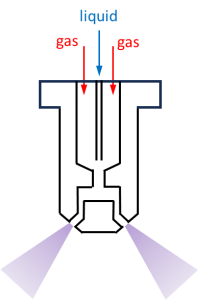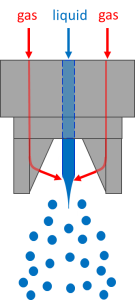Sprays in the Process Industries
“Say it, don’t spray it.” Generally, this is good advice, but in industry it’s often profitable to spray it. In simple terms, sprays mix liquid droplets into gas, often with the aim to generate high interfacial area. In the process industries, the use of sprays is widespread. For instance:
- Thermal quenching/cooling of hot gas, liquid, or surface
- Gas treating/absorption
- capture of CO2 into an amine droplet
- acid gas quenching with alkaline water
- odor control
- Evaporation
- spray drying (rapid removal of solvent component)
- injection of a liquid reactant (rapid and complete evaporation required before gas phase reaction)
- feed or catalyst injection into a gas phase process, including combustion/ incineration
- Solid particle capture
- Demisting
- Defoaming, e.g., knocking down foam in a tank to prevent reaching the vent system.
Sprays are most often steady, but can also be pulsed, such as for coating of individual elements in an assembly line or for fuel injectors.
Sprays also efficiently spread liquids to and across a targeted region:
- Flow distribution over a large area
- feed or reflux over column packing
- liquid dispersion over a vertical tube sheet
- tank rinsing
- fire quench
- cooling mist over a crowd of people
- irrigation of crops
- Surface wetting, such as inhibiting surfaces from fouling
- Cleaning (impact force)
- removing filter cake from cloth, screens
- removing contamination, e.g., pressure washing, car wash
- Apply a chemical/formulation
- paint coating
- powder coating
- resin coating (e.g., electronics)
- agricultural sprays from booms or drones.
- disinfection
There are also sprays that are unintended, such as when a distillation column generates excessively high vapor velocity that strips off a liquid mist, or when herbicide mist drifts to an unintended location due to wind currents. Of course, we’re all familiar with unintended sprays generated by sneezes that can generate airborne contagions.
Factors in nozzle selection
Contrary to the ”thumb over the garden hose“ approach, industrial spray nozzles are high precision devices, and selection of the wrong nozzle can have serious consequences to your process. Important factors in the nozzle selection process include:
- Drop size statistics (e.g., D50 median, D10 for fines, D90 for largest droplets)
- Mass flux distribution (“Patternation”)
- full cone, hollow cone, flat fan distributions
- Spray angle
- Target impact force
- Droplet ballistics
- drift of droplets in wind environment, characterized by fines content, D10.
- determine if spray rinse will reach all the tank walls
- Surrounding gas entrainment
- secondary currents generated
- Material of construction requirements
Hydraulic (single fluid) nozzles use the liquid motive force to drive atomization. Commonly, this is related to the pressure drop of the liquid through an orifice, or in other cases related to impingement (splashing) of a liquid jet onto a solid surface. The pressure drop is dominated by the inertial term, i.e., KρL(Δv)2, where K is close to 0.5. The ρL is the liquid density and Δv is the velocity change of the liquid through the nozzle. They are available in a wide range of designs, materials of construction (in some cases even fiber reinforced plastic), and performance attributes. Flowrates can range from thousands of gpm to well less than 1 gallon/hour. Hydraulic nozzles are simple, cheap, and preferred for any situation in which they can work.
Other nozzles in use are gas-assist (or “two-fluid”) nozzles. Most commonly the gas (second fluid) is air. In internal mix nozzles, the gas and liquid are fed into the nozzle and mixed. See Figure 1. The gas expands due to pressure drop throughout the nozzle; the expansion work of the gas provides the work of atomization. The exit gas velocity may be on the order of 100 ft/s at the exit pressure in the vessel. Several spray exit holes may be utilized.


Figure 1. Operating principle of an internal mix nozzle. Photo on right shows operation with a selected side-by-side gas and liquid feed entry [1].
In external mix nozzles, the liquid is jetted through an orifice and multiple gas jets impinge on the liquid jet to a break it up, causing atomization. See Figure 2. For external mix nozzles, if the gas flow is insufficient, a rope of liquid will survive without atomization.

Figure 2. Principle of operation for external mix nozzle
Gas-assist nozzles are used most commonly for a few reasons:
- When a relatively large flow (tens of gallons per minute) needs to be atomized to relatively small droplets (order of a hundred microns). This is generally beyond the capability of single hydraulic nozzles, although if space limitations are not a factor, an array of smaller hydraulic nozzles can be used.
- When a viscous fluid needs to be atomized, “viscous” meaning on the order of hundreds to a few thousand centipoises. For a glycerin-like material, an air-assist nozzle may be the only practical option to make small droplets.
- The drop size is less sensitive to liquid flow rate (at given gas flow) than are hydraulic nozzles. Furthermore, gas-assist nozzles are essentially “instant on” if the gas flow is started first. There are essentially no large droplets generated as the liquid flow rate is ramped up, in contrast to hydraulic nozzles.
- For cases in which the nozzle is located in a superheated environment for the liquid feed, the assisting gas can provide cooling, thereby eliminating choking in the nozzle internals due to premature flashing.
Regardless of the nozzle type, the drop size statistics reported by the nozzle vendors[1] assume water flowing into air at STP. The drop size statistics don’t necessarily consider secondary atomization caused by the gas shearing apart the primary droplets. If you are spraying a liquid feed into a high velocity hydrocarbon vapor in a pipe, for instance, the proper Weber number and Ohnesorge number calculations should be considered for the spray environment to account for surface tension, densities, and viscosities that differ from STP air and water.
On viscosity, it is important to consider that spray nozzles impart very high shear to the liquid being sprayed; an average shear rate of 100K s-1 is possible. A relatively viscous Newtonian fluid, like glycerin or corn syrup, will not spray in a hydraulic nozzle; a liquid “rope” or film is formed instead. However, a latex formulation, which has similar viscosity to glycerin at low shear, can spray like water in a hydraulic nozzle. The reason for this is that latex is a shear thinning material and is water-like (or close enough) at the shear rate imparted by the nozzle.
A useful rule of thumb to determine whether a material will spray in a hydraulic nozzle is to calculate the Reynolds number based on the nozzle orifice diameter and corresponding liquid properties and velocity in the orifice; a Reynolds number less than ~ 1000 is not turbulent and will not spray.
Feel free to contact Becht for further discussions on this topic or other topics related to droplet behavior.
Further reading
Lipp, C.W., Practical Spray Technology: Fundamentals and Practice, Lake Innovation LLC, 2012.
Lefebvre, A.H., McDonell, V.G., Atomization and Sprays, 2nd ed., CRC Press, 2017.
Nasr, G.G., Yule., A.J., Bendig, L., Industrial Sprays and Atomization: Design, Analysis and Applications, Springer, 2002.
Reference
- Cloeter, M.D., Bai, H., Sen, S., Smith, B., “Spray Technology for Control of Reactor Selectivity”, presented at the Institute for Liquid Atomization and Spray Systems (ILASS) – Americas annual conference, 2012, San Antonio, TX.
[1] Vendors may not openly publish drop size statistics for their nozzles, but usually will give them to potential customers if asked.
